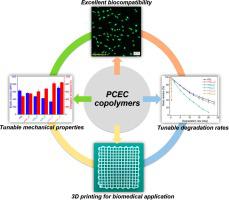European Polymer Journal ( IF 5.8 ) Pub Date : 2023-08-28 , DOI: 10.1016/j.eurpolymj.2023.112388 Yu-Yao Liu , Juan Pedro Fernandez Blazquez , Guang-Zhong Yin , De-Yi Wang , Javier Llorca , Mónica Echeverry-Rendón

|
Biodegradable and biocompatible 3D printable biomaterials with tunable mechanical properties and degradation rate adapted to target tissues were urgently required to manufacture scaffolds for tissue regeneration. Herein, a strategy based on a series of copolymers are proposed where the mechanical and degradation properties can be optimized regarding the specific biological application. With this purpose, poly(ɛ-caprolactone)-poly(ethylene glycol)-poly(ɛ-caprolactone) (PCL-PEG-PCL, PCEC) triblock co-polymers with high molecular weight were synthesized by using PEG with a wide range of molecular weight (from 0.6 kg/mol to 35 kg/mol) as macroinitiators. PCEC copolymers exhibited tunable mechanical properties with an elastic modulus in the range 338–705 MPa and a degradation rate from 60% mass loss after 8 h to 70% mass loss after 23 days in accelerated tests, as well as excellent cytocompatibility and cell attachment after culture with mouse fibroblast L929 cells. The mechanisms responsible for these properties were ascertained by means of different techniques to ascertain the structure–property relationship in PCEC copolymers. Furthermore, it was shown that it is possible to manufacture PCEC scaffolds by 3D printing with excellent dimensional accuracy and controlled microporosity. This study provides a promising strategy to design, select, and fabricate copolymers with tunable mechanical properties and degradation rate for tissue engineering applications.
中文翻译:

为生物医学应用定制 PCL-PEG-PCL 基共聚物的机械和降解性能的策略
迫切需要具有可调节机械性能和适应目标组织的降解率的可生物降解和生物相容性3D打印生物材料来制造用于组织再生的支架。在此,提出了一种基于一系列共聚物的策略,其中可以根据特定的生物应用来优化机械和降解性能。为此,采用多种分子量的PEG合成了高分子量的聚(ε-己内酯)-聚(乙二醇)-聚(ε-己内酯)(PCL-PEG-PCL、PCEC)三嵌段共聚物。分子量(0.6 kg/mol 至 35 kg/mol)作为大分子引发剂。PCEC 共聚物表现出可调的机械性能,弹性模量在 338-705 MPa 范围内,在加速测试中降解率从 8 小时后的 60% 质量损失到 23 天后的 70% 质量损失,以及在加速测试后具有优异的细胞相容性和细胞附着性。与小鼠成纤维细胞 L929 细胞培养。通过不同的技术来确定 PCEC 共聚物的结构-性能关系,从而确定了这些性能的机制。此外,研究表明,可以通过 3D 打印制造具有优异尺寸精度和受控微孔率的 PCEC 支架。这项研究为设计、选择和制造具有可调机械性能和降解率的组织工程应用的共聚物提供了一种有前景的策略。与小鼠成纤维细胞 L929 细胞培养后具有良好的细胞相容性和细胞贴壁性。通过不同的技术来确定 PCEC 共聚物的结构-性能关系,从而确定了这些性能的机制。此外,研究表明,可以通过 3D 打印制造具有优异尺寸精度和受控微孔率的 PCEC 支架。这项研究为设计、选择和制造具有可调机械性能和降解率的组织工程应用的共聚物提供了一种有前途的策略。与小鼠成纤维细胞 L929 细胞培养后具有良好的细胞相容性和细胞贴壁性。通过不同的技术来确定 PCEC 共聚物的结构-性能关系,从而确定了这些性能的机制。此外,研究表明,可以通过 3D 打印制造具有优异尺寸精度和受控微孔率的 PCEC 支架。这项研究为设计、选择和制造具有可调机械性能和降解率的组织工程应用的共聚物提供了一种有前途的策略。此外,研究表明,可以通过 3D 打印制造具有优异尺寸精度和受控微孔率的 PCEC 支架。这项研究为设计、选择和制造具有可调机械性能和降解率的组织工程应用的共聚物提供了一种有前途的策略。此外,研究表明,可以通过 3D 打印制造具有优异尺寸精度和受控微孔率的 PCEC 支架。这项研究为设计、选择和制造具有可调机械性能和降解率的组织工程应用的共聚物提供了一种有前景的策略。





















































 京公网安备 11010802027423号
京公网安备 11010802027423号